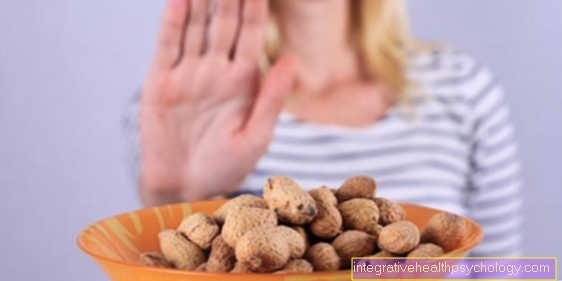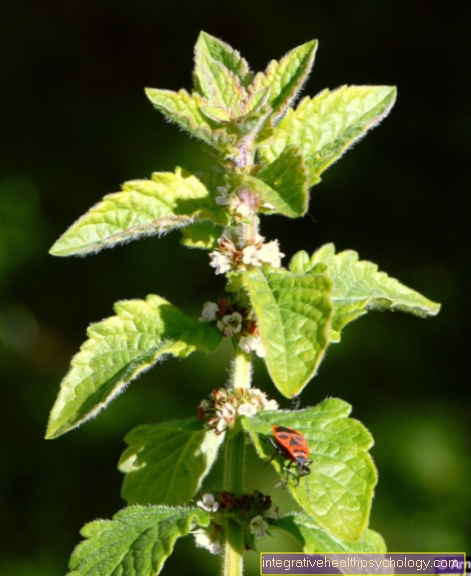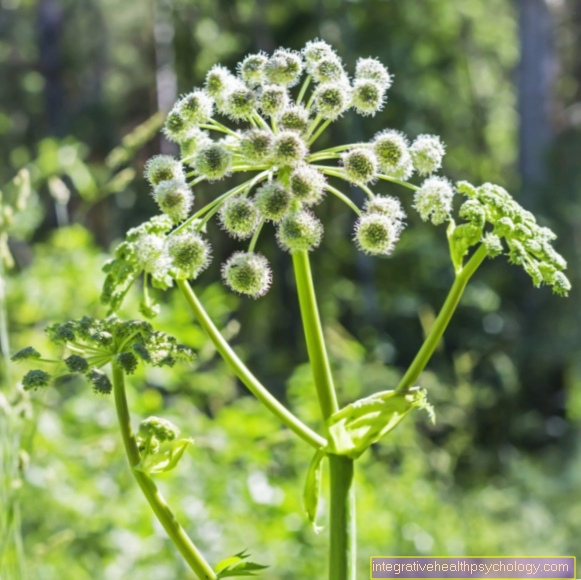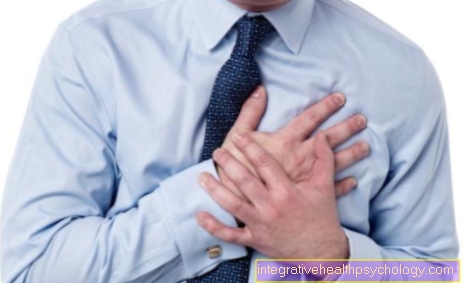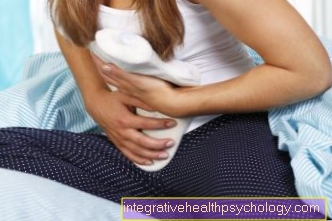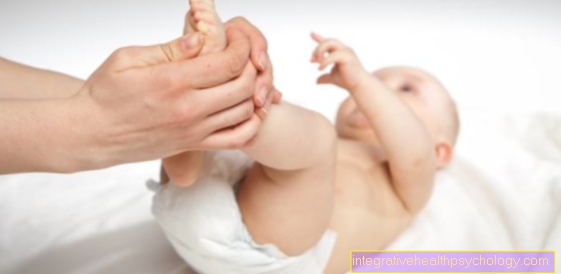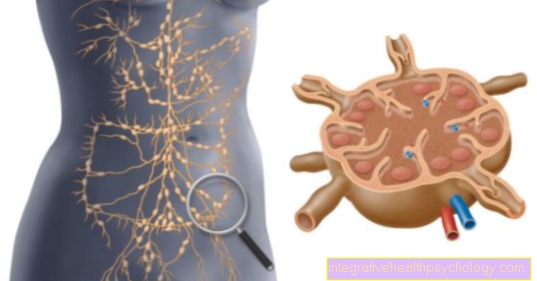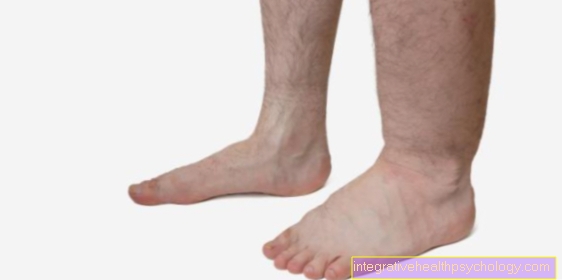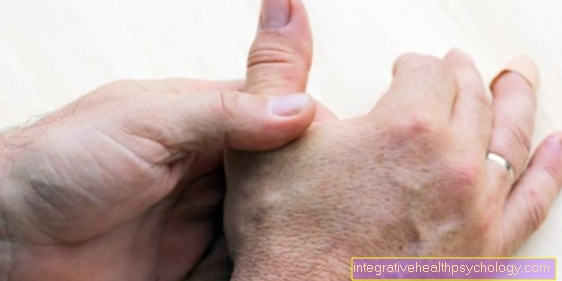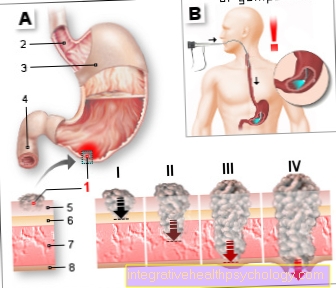Gastrointestinal infection
introduction
Gastrointestinal infections are also known as gastrointestinal flu or technically as gastroenteritis. Viruses are usually the cause of gastrointestinal inflammation, but they can rarely be caused by bacteria. The course of a viral gastrointestinal infection is usually milder than that of a bacterial infection. A gastrointestinal infection causes inflammation of the stomach and intestinal mucosa.

Symptoms
The symptoms of a gastrointestinal infection usually appear relatively suddenly. The most typical symptoms are vomiting and diarrhea. Sometimes the diarrhea contains mucus or blood. Vomiting usually stops faster than diarrhea. Vomiting usually lasts for a day or two, while diarrhea can last for a week.
Read more on the subject at: Bowel movements like water
The symptoms are usually accompanied by nausea and abdominal pain. The abdominal pain can increase to abdominal cramps. In addition, it can lead to headaches and body aches and general exhaustion (see also: abdominal pain and headache). In rare cases, a slight fever occurs, depending on the pathogen. The severity of the complaints also depends on the pathogen.
Read more on the topic: Fever, dizziness and headache
The fact that the body loses a lot of fluids and important electrolytes through vomiting and diarrhea can lead to circulatory problems. Small children and the elderly in particular are very sensitive to this loss of fluid. Nausea and vomiting are usually the first symptoms that occur, as the pathogen is absorbed through the mouth and can damage the lining of the stomach first. By attacking the mucous membrane, a signal is sent to the brain, which ensures that nausea is triggered, whereby the body tries to get the pathogen out of the body. A little later, when the pathogens have reached the intestine and multiplied there, the diarrhea occurs. Diarrhea is when the stool is soft to watery more than three times a day.
You can find out more about the topic here: Burning in the intestines
root cause
The cause of a gastrointestinal infection is mostly a virus. Some viruses are in the foreground. These include the noroviruses, Rotaviruses, Coronavirus and Adenoviruses. The two most common triggers of gastrointestinal infections are noroviruses and rotaviruses.Especially with noroviruses, the disease progresses violently, which can lead to circulatory problems, especially in older people due to the loss of fluids.
Common bacterial pathogens are for example Campylobacter, Chlostridium difficile, Salmonella, Escherichia coli or Yersinia. The bacterium that is responsible for cholera also leads to diarrhea, which is more likely to occur in countries with poor hygienic conditions.
Which pathogens cause gastrointestinal infections?
The two most common pathogens for gastrointestinal infections are the two viruses "norovirus" and "rotavirus". The norovirus is more likely to be responsible for an infection in older adults and occurs most frequently between October and March. Rotavirus most commonly affects children under the age of 5, which is why an oral vaccine was developed for infants. There are also some bacteria that can cause diarrhea. They are significantly less responsible for such an infection than the viruses. They include salmonella, which get into the body through contaminated food, or shigella, which occurs in contaminated water, for example. Other bacterial pathogens are the cholera bacteria, the Yersinia and the Campylobacter. All diarrheal diseases are characterized by a more severe course and additional symptoms, such as blood in the stool and a weakness similar to flu. They usually last significantly longer than a week and thus longer than a viral infection. Parasites are another cause of diarrhea. These include worms as well as amoebas, which almost always triggered the disease as part of a trip to the tropics.
More information can be found here: Gastrointestinal Virus - Causes and Treatment
Diagnosis
Usually the doctor gives a Investigation interview and a physical examination performed. However, one can also use a Stool sample take, which can be used to determine the pathogen if necessary.
When do I have to see a doctor?
The most dangerous complication of a gastrointestinal infection is severe water shortage. If the sick person cannot provide himself or herself with sufficient water by drinking, a doctor should be consulted. He can ensure the supply by supplying fluids and nutrients via the vein and also administer medication to reduce vomiting. In addition, a doctor should be called if there are other symptoms besides vomiting, diarrhea and stomach pain, joint pain, kidney pain and pneumonia are just a few examples. If the gastrointestinal infection lasts longer than 6 days, a doctor should be consulted to rule out other diseases or to prevent a dangerous course.
When does an antibiotic help?
An antibiotic only works against bacteria. Since most gastrointestinal infections are caused by viruses, antibiotics are useless. However, there are also some diarrhea illnesses that are caused by bacteria. They are characterized by a more violent course, such as bloody stools and a flu-like weakening. They are also usually longer lasting. In these cases, it is often necessary to resort to an antibiotic. Fortunately, these bacterial diarrheal diseases have become rather rare in Germany.
You may also be interested in this article: Treatment with antibiotics
How can I tell the difference between gastrointestinal infections and food poisoning?
Food poisoning is characterized by the fact that it causes discomfort within a few hours of ingesting food. These are often nausea, vomiting and diarrhea, as is the case with a gastrointestinal infection, which makes it difficult to differentiate. However, food poisoning can also cause nerve paralysis of all kinds, liver problems, fever and reddening of the skin. For this reason, in the case of complex new symptoms together with gastrointestinal complaints shortly after ingestion of food, food poisoning can be assumed.
You may also be interested in this article: Food Poisoning Symptoms
What to do with gastrointestinal infections
Most of the time, the cause of a gastrointestinal infection cannot be treated. Unless it is caused by a bacterium, then you can give an antibiotic. As a rule, symptomatic therapy is usually followed, which is primarily aimed at compensating for the loss of fluid and electrolytes. Mineral water and unsweetened herbal teas are particularly suitable for balancing. Sweet drinks, such as the cola often given for illness, should be avoided. Because the sugar means that even more water is drawn into the intestine, so that the loss of fluid is increased even further.
Rusks and clear soups are suitable as food, especially after the vomiting has subsided after a day or two. In addition to these measures, bed rest should be observed so as not to overwork, as the body needs enough strength to fight the pathogen. Usually the body is able to fight the disease on its own and no further measures need to be taken.
In the case of diarrhea in young children or the elderly, it may sometimes be necessary to give them special electrolyte-sugar solutions, as they are more sensitive to fluid loss. Old people with previous illnesses are particularly at risk. This special liquid contains electrolytes like sodium, Potassium chloride and table salt as well as the nutrient grape sugar. In extreme cases, a hospital stay is necessary in order to supply fluids and electrolytes via the vein. To further offset the Elektorlyt loss, eating bananas for potassium loss and pretzel sticks for sodium loss will help. If so, it is best to consume both so that both electrolytes are balanced. In the case of very severe nausea or very severe diarrhea, medication can be purchased from the pharmacy to relieve these symptoms. Help against diarrhea, for example Loperamide and Activated carbon, however, they should not be used on children.
Read more on the topic: Medicines for gastrointestinal diseases
What can I eat if I have a gastrointestinal infection?
During a gastrointestinal infection, the sick are allowed to eat anything they want. In most cases, however, the situation is that they do not feel an appetite or even react to a meal with nausea. You can offer them bread, rusks or a soup, which is particularly easy to digest and tastes less intense. However, it is even more important during this time that the sick drink enough. If this works, you can stir fruit juices or some sugar into the drink to absorb energy in order to give the body some calories and minerals.
Homeopathy for gastrointestinal infections
So far there is insufficient evidence that homeopathy cures diseases or accelerates their healing. However, there is a large following of homeopathy who have developed a wide variety of preparations. There are also some remedies for gastrointestinal infections and their individual complaints, such as Arsenicum album, Cocculus and Ipecacuanha, for example. Try out the means and get an idea of them for yourself. The concentration in which these are sold cannot cause any significant side effects, which is why they are offered over the counter.
Further information on the subject can be found here: Homeopathy for gastrointestinal infections, home remedies for gastrointestinal flu
Accompanying symptoms in gastrointestinal infections
Back pain with gastrointestinal infection
In the case of a gastrointestinal infection, abdominal pain often occurs along with nausea, vomiting and diarrhea. However, the inflamed and overactive intestine often radiates its pain to the patient's back. If necessary, a doctor should examine whether there is kidney involvement, i.e. whether the kidneys are affected by the disease, which can also cause back pain. It is not uncommon for back pain to also arise because the gastrointestinal patient lies down a lot and does not move enough, at least for his back. This can also be a reason for stiffening, which manifests itself in back pain. If the pain persists for a long time or is particularly severe, the patient should be examined thoroughly by a doctor.
You may also be interested in this article: When stomach and back pain coexist
Joint pain with gastrointestinal infection
If joint inflammation occurs a few weeks after a gastrointestinal infection, it is very likely that it is a so-called "post-infectious arthritis". It is caused by diarrheal disease caused by the bacteria Shigella, Yersinia, Salmonella or Campylobacter. Usually only a few joints of the legs are affected and the joint inflammation heals within a few weeks without consequences. The joint pain can also occur as part of the "Reiter triad". This refers to the three complaints of ureter, joint and iris inflammation of the eye. This disease heals in 80% of cases within one year without consequences. Unfortunately, the disease can also transition into a chronic rheumatic form.
You can find more information here: Joint pain
Pain in the limbs with gastrointestinal infection
In addition to symptoms such as nausea, vomiting and diarrhea, headaches and body aches can also occur with a gastrointestinal infection. They are often signs of a lack of salt and water caused by the infection. As a rule, this pain disappears again soon after the point at which it is possible to eat and drink normally again. If they last significantly longer than the symptoms of the infection, a doctor should be consulted who will thoroughly examine the muscle and bone substance.
You might also be interested in this article: Body aches
Kidney pain with gastrointestinal infection
Kidney pain should always be taken seriously. They are often signs of inflammation or injury that should be treated very often. In connection with a gastrointestinal infection, pain can be caused by the lack of water, but also a complication of the bacteria E. coli and Shigella. You can use a so-called "hemolytic uremic syndrome“(HUS), which manifests itself in bleeding and kidney failure. Kidney pain in connection with a gastrointestinal infection should therefore be examined by a doctor and treated if necessary.
You can find more information here: Kidney pain: What to do?
Duration of a gastrointestinal infection
A gastrointestinal infection usually subsides relatively quickly. How long it actually lasts depends on the pathogen and the age and condition of the patient. In general, however, one can say that an illness lasts between two and six days. If the illness lasts longer than six days at the latest, you should see your family doctor. An infection with noroviruses usually lasts for one to three days, although exhaustion and a feeling of illness can last longer. In the case of a rotavirus infection, the specified two to six days apply.
Please also read: Duration of gastrointestinal flu
How long does a gastrointestinal infection last?
How long a gastrointestinal infection lasts depends on the cause of the infection. An uncomplicated gastrointestinal infection caused by a norovirus lasts about 12 to 48 hours in most cases. This gastrointestinal infection occurs more frequently in the cold season. However, when infected with the rotavirus, it often takes 2 to 6 days for the symptoms to subside. It is found particularly often in children and is often associated with other symptoms such as fever and difficult breathing. Due to this rough classification, the two can often be distinguished from one another. These two viruses are responsible for the majority of gastrointestinal infections. This means that most infections of this type are healed within a few hours to a maximum of a week. If the symptoms persist or if new symptoms arise, a doctor should be (re-) consulted.
More information can be found here: Norovirus - How Dangerous Is It?
What should be considered with the baby?
Babies and toddlers are often affected by gastrointestinal infections because their immune system is not yet mature and has not yet come into contact with many pathogens. On average, children up to their third year of life get such an infection once or twice a year.
Rotaviruses are mostly responsible for gastrointestinal infections in small children. There is a vaccination against these viruses, which is approved by the Standing Vaccination Commission (STIKO) is recommended. It is the first vaccination that can be given to children from the age of six weeks. A vaccination after the sixth month of life is no longer useful. Especially with the rotaviruses, babies are threatened with dehydration due to gastrointestinal infections, which is why a doctor should be consulted in case of illnesses below the sixth month of life.
The rotaviruses are followed in their frequency by the noroviruses. They occur more frequently from October to March. They are the most common gastrointestinal virus pathogen in adults. In contrast to the rotavirus, there is no vaccination against the norovirus. It is a good idea to continue to breastfeed the baby during the illness, as breast milk contains active ingredients that can fight diarrhea. Boiled water and fennel teas are also helpful. If there is a risk of dehydration, which is noticeable, for example, by a dry tongue and restlessness, the child should be given special electrolyte solutions that can be purchased in the pharmacy. On the one hand, they compensate for the lack of fluids and the lack of electrolytes. Sweet drinks and food should be avoided in any case, as they make diarrhea worse.
Drug therapy should also be avoided. If you have diarrhea, you should make sure that the liquid stool does not lead to diaper rash.
Gastrointestinal infection during pregnancy
If there is a gastrointestinal infection during pregnancy, there is no risk of infection for the child. However, particular care must be taken to ensure that the pregnant woman is supplied with sufficient water. If the permanent complaints do not provide adequate care, in-patient care should be considered. Therapy with fluids and medication can be achieved there in an emergency via the vein. During pregnancy in particular, care must be taken to ensure that both the child and the mother have an adequate supply of minerals, which can easily become unbalanced by frequent vomiting and diarrhea. But if the pregnant woman is still doing so well that she can easily supply herself with enough water, the gastrointestinal infection can and should be cured at home.
You can find more information here: Diarrhea in Pregnancy
Is it allowed to breastfeed during a gastrointestinal infection?
Of course, a sick mother should, if she can, continue to breastfeed her child. The gastrointestinal viruses are not passed on to the baby via the breast milk, but the child receives valuable antibodies and other defense-promoting substances via the milk. You should therefore continue to breastfeed your child during a gastrointestinal infection. During this time, the sick mother, like the rest of the family, should pay particular attention to hygiene. As a mother, it is also advisable not to kiss the baby on the face during this time. Viruses could be transmitted to the child in the process.
You may also be interested in this article: Breastfeeding behavior
Infection with gastrointestinal infection
Gastrointestinal infections are contagious. Compared to other diseases, they have a high potential for contagion, which is why several members of a family or several patients in hospital are often affected. Infection usually takes place via a contact / smear infection. This happens when the pathogens causing the disease are transferred from the stool or vomit to objects or surfaces that are in turn touched by other people. The pathogens can then get into the mouth via the hands. This type of transmission is known as fecal-oral transmission.
In addition to the smear infection, some pathogens can also be transmitted via droplet infection. The most important example of this is the norovirus, which is why it poses an enormous risk of infection. A droplet infection can occur especially when only a few viruses are sufficient to trigger an illness. The smallest virus-containing drops can be transmitted to another person through the air when they vomit, speak or cough.
Some pathogens can also be transmitted from animals to humans. These include salmonella or EHEC (Enterohemorrhagic Escherichia coli). Most of them are infected through contaminated animal products such as eggs or milk. The transmission is often aided by insufficient cooling of the food. The patients are naturally particularly contagious in the acute phase of the disease, but infection can also take place one to two days before and after the symptoms of the disease. Transmission occurs frequently, especially in countries with poor hygienic conditions.
Due to the risk of infection, it is important that those affected and contact persons adhere to hygiene measures. This includes, above all, frequent and thorough hand washing. The noroviruses are a special case of infection. You are contagious for at least 48 hours after the symptoms of the disease have subsided. Furthermore, the viruses are excreted in the stool for weeks so that an infection can also occur at a later point in time.
How long is a gastrointestinal infection contagious?
A gastrointestinal infection is generally very contagious. The greatest risk of infection is during the patient's complaints, because during this time the patient carries a particularly large number of viruses and through diarrhea and vomiting they spread them through the air and through direct contact with others. However, the risk of infection remains increased for about 48 hours even after the absence of vomiting and diarrhea. During this time, the sick person can experience spontaneous complaints again. Only after 48 hours of freedom from symptoms is the patient considered healthy and thus the risk of infection decreases. However, the pathogens are often excreted in the stool days to weeks after infection. A high level of hygiene should therefore also be maintained for a long time after the gastrointestinal infection, both by those affected and by contact persons.
Incubation period of a gastrointestinal infection
Under the incubation period one understands the time that passes from the point in time at which the pathogen enters the body until the first symptoms of the disease appear. Because only when the pathogen has multiplied sufficiently and has not been eliminated by the immune system beforehand does the disease break out and symptoms appear.
The incubation period is individually different for each pathogen and also varies from person to person. In the case of gastrointestinal pathogens, it usually takes between four and 48 hours for the first symptoms to appear. The norovirus has a particularly short incubation time. It is between six and 50 hours. With rotavirus, the incubation period averages three days.
Gastrointestinal infection without diarrhea
In addition to vomiting, diarrhea is part of a real gastrointestinal infection. Since the pathogen ultimately makes its way into the intestine via the mouth and stomach, where it leads to damage and consequently to diarrhea. However, in some people the immune system is able to keep the symptoms of the disease or the pathogen in check, so that the symptoms can only be weakened, so that the diarrhea can sometimes not occur.
You might also be interested in this topic: Intestinal cramps without diarrhea
Complications
Complications are very rare with a gastrointestinal infection, as it is usually a harmless disease that the body can fight on its own. However, it comes to one large fluid and electrolyte loss, it can through the Lack of volume to a so-called hypovolemic shock because there is not enough blood in the body due to the lack of fluid and the blood pressure is too low as a result. If care is taken to drink enough fluids during the illness, this complication can usually be easily averted. Hypovolemic shock is most common in countries with poor medical care. In these countries, diarrhea is often fatal. It can also lead to hypoglycaemia (Hypoglycemia) come. In very rare cases, the disease causes one Intestinal perforation or blood poisoning.

